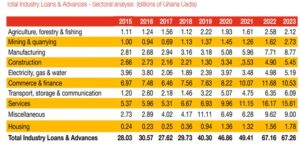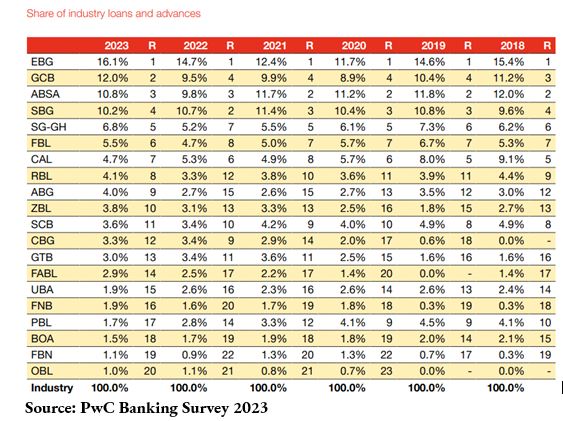By Joshua Worlasi AMLANU & Ebenezer Chike Adjei NJOKU
Five banks in the country – Ecobank, GCB Bank, Absa, Stanbic and Société Générale – held 55.9 percent of all loans and advances in 2023, up from 54.6 percent the previous year PwC’s latest Banking Survey has shown.
The banks held 16.1, 12, 10.8, 10.2 and 6.8 percent respectively of the industry’s loan book, which hit GH¢67.26billion last year; a modest 0.15 percent increase over the previous year. The value of loans was also 33 percent of deposits’ total value.
This concentration of lending, analysts say, raises questions about the broad posture of banks toward extending credit for businesses and entrepreneurs, seeing that the industry’s total deposits rose from GH¢163.7billion in 2022 to GH¢201.73billion in the year under consideration. This is especially so when inflation is accounted for.

Sectors
Diving deeper into the data, a nuanced picture of the industry’s lending priorities emerges. The commerce and finance sector remains the darling of lenders, experiencing a robust 10 percent year-on-year increase in loans.
This sector, along with services, now accounts for 38.9 percent of total industry loans, which some say highlights the country pivoting toward a service-oriented economy.
Manufacturing also emerged as another bright spot, with its share of total loans climbing from 11.5 percent to 13 percent. Additionally, credit to the mining and quarrying industry almost doubled from 2.4 percent to 4.1 percent.
However, not all sectors have fared equally well in the race for credit. Perhaps most concerning is the agricultural sector’s performance. Despite its crucial role in employment and food security, agriculture saw its share of loans shrink from 3.8 percent to 3.2 percent. This decline raises red flags about the banking sector’s support for rural development and food production.
8-year trend
In 2015, the total industry loans and advances stood at GH¢28.03billion. Fast forward to 2023 and this figure has skyrocketed to GH¢67.26billion, marking a 140 percent increase over eight years. However, this growth has not been entirely linear.
The sector experienced a slight contraction in 2017, with total loans dipping to GH¢27.62billion in the lead-up to the financial sector shake-up. By 2019 the total had rebounded to GH¢40.3billion, crossing the GH¢40billion mark for the first time.
The years 2020 and 2021 saw continued growth in nominal terms, with total loans reaching GH¢46.86billion and GH¢49.41billion respectively despite global economic challenges posed by the COVID-19 pandemic.
The most dramatic growth occurred between 2021 and 2022, with total loans leaping to GH¢67.16billion. However, this rapid expansion seems to have hit a plateau in 2023, with only a marginal increase to GH¢67.26billion – representing a growth rate of just 0.15 percent.
Diving into sectoral trends, the data reveal significant shifts in lending priorities over the years, albeit consistent with the 2022/2023 trend. The Commerce and Finance sector has consistently dominated, growing from GH¢6.97billion in 2015 to GH¢10.53billion in 2023. The Services sector has also seen substantial growth, nearly tripling from GH¢5.37billion to GH¢15.61billion over the same period.
The transportation, storage and communication sectors have been the biggest beneficiary, with a 407.5 percent increase in the value of loans from GH¢1.2billion in 2015 to GH¢6.09billion in 2023.
Manufacturing has shown steady progress, with loans increasing from GH¢2.81billion in 2015 to GH¢8.77billion in 2023. This trend suggests a gradual shift toward supporting Ghana’s industrialisation efforts.
Interestingly, some traditionally strong sectors have seen fluctuations. Mining and Quarrying, for instance, has experienced significant volatility, reflecting the cyclical nature of commodity markets.
Agriculture, Forestry and Fishing, while growing in absolute terms from GH¢1.11 billion to GH¢2.12billion, have seen their share of total loans decline – raising questions about support for rural development.
In response to these trends, the Bank of Ghana has recently introduced a new cash reserve ratio (CRR) policy aimed at encouraging broader lending practices. However, the effectiveness of this measure remains to be seen.
While tapering inflation has analysts anticipating a modest cut to the Monetary Policy Rate, and the Ghana Reference Rate stood at 29.35 for July 2024, the average lending rate is expected to remain above 30 percent for the foreseeable future.










